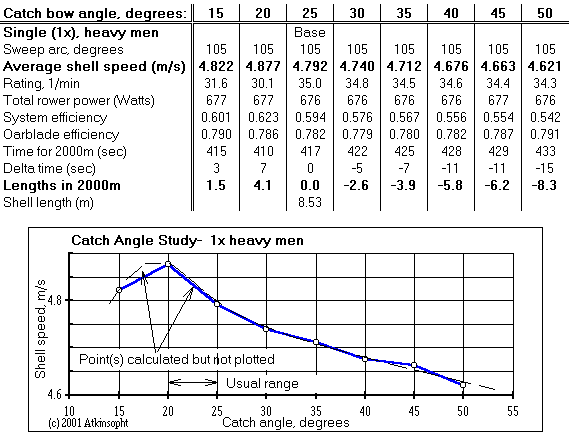 Figure 1
Figure 1
Bow angle: The angle between the oarshaft and the longitudinal axis of the shell; zero at the bow, 90 degrees athwartship, and 180 degrees at the stern; "theta" in the diagrams and expressions in this paper.
 Figure 1
Figure 1
The result seems to show that scullers--either through evolution or good fortune--have hit upon the near optimum catch bow angle and that to err on the small side has no concealed "pinch" penalty. Scullers might want to experiment with reducing the current blade cant angle from about six to zero degrees. Easiest might be to reconsider the Macon blade if that can be done without sacrificing blade surface area.
I have recently (2016) had a communication from Havaard Grunnvaag of Norway pointing out that ROWING's computer optimised bow angle (20 degrees) is essentially the same as Kleshnev's conclusion (68-70 degrees) arrived at by empirical means. (Note a 90 degree phase difference in our angle reckoning.) I'd like to think that this agreement says something about the validity of our corresponding work.
 Figure 2
Figure 2
The result seems to show that "sweepers"--for geometrical reasons--have been unable to avail themselves of an optimum catch bow angle. At small angles the sweep oarhandle is awkwardly out of reach over the saxboard at normal rigger spreads. And if the spread is reduced to better this condition the mid-stroke handle arc swings just as awkwardly out over the opposite side.
Innovative coaches and boat, and oar designers may be able to improve catch conditions somewhat for sweep boats but it doesn't look easy. Tinkering with as much reduced spread as remains practical may have some small benefit-- but see the ROWING blade cant angle results. Sweepers should consider testing blades with negative cant. If I were an oarblade designer negative cant for sweeps (and zero for sculls) is absolutely the first thing on which I would experiment.